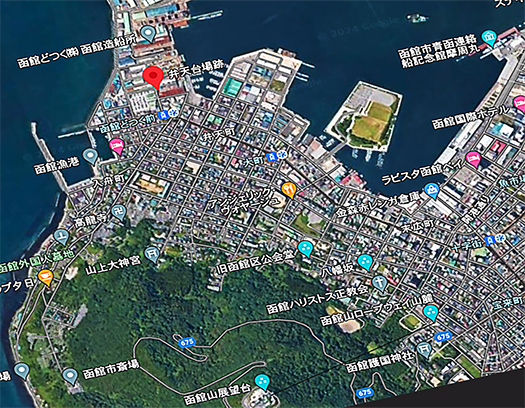

先日来、わたしのMacデータ中の北海道の古写真類の整理作業も行ってきていますが、そのなかに先般深掘りしていた「中世の武家の北海道移住痕跡」〜函館志苔館・小林氏居館シリーズと関連しそうな古写真を発見しておりました。って、ちょっと時代相が違いすぎるかなぁ(笑)。
あの志苔館は創建は1300-1400年代ということで室町期。最古で考えると700年以上前の痕跡。
北海道人としては、明治期以降の動きが今現在にも直接つながっている感覚が一般的で、それが一気に500-600年さかのぼっての歴史の深掘りだった。で、こちらの方はいろいろ掘り起こしを続けていきたいと思っていますが、今回の写真整理で「明治初年」とされた、いまも残っている「弁天砲台」を函館山山頂から見下ろした古写真を発見したのであります。
対比参考にするのに、現代のGoogleMapの方向をほぼ同方向視点とさせてみた。
函館山から、北西方向を見下ろしたような写真。明治初年というと明治3年の「札幌市街」の入植人数が13人、明治4年では637人という対比的状況が記録されている。開拓使「判官」の島義勇の事跡では、1869(明治2年)48歳 蝦夷開拓使首席判官として北海道に赴任とある。その後明治3年には蝦夷開拓使首席判官解任/明治天皇の侍従に任命という波瀾万丈の時代相。
ちなみに今も北海道神宮の境内のすぐ前にかれの像が置かれている。明治国家としての「北海道開拓史」のなかの重要人物の事跡。なんといっても、明治帝の発願を受けて北海道開拓の3神を背中に背負って、函館に上陸しそこから現在の小樽市銭函まで北上して、松浦武四郎の献策を踏まえて札幌に「本府」を開設し開拓の神威をこの地に根付かせた人物の事跡なのです。
この写真の函館の開発状況を見ると、かなりの市街地状況であり、船の往来も非常に活発。
その地から、まだ人口が13人という未開の「奥地」札幌に分け入ったことになる。
その時点以降の札幌の開発は相当に歴史資料があるけれど、逆に函館の状況がこのように見えて、非常に興味深い。
志苔館への戦国初期の和人武装勢力の進出からシャクシャインの戦いが引き起こされた北海道島全体の状況の時期から、一気に時空移動した感覚が新鮮に目覚めさせられる思いなのですね。
道南十二館の時代から、この明治初年に至るまでの「函館地域史」には、当然、高田屋嘉兵衛などの活躍などの大きなテーマもある。司馬遼太郎の「菜の花の沖」という歴史掘り起こし業績も参照できる。
1枚の写真から、北海道通史的な視点も呼び覚まされる。う〜む、健康第一で長生きして、掘り起こし続けたいものです。
English version⬇
A view of the city center from Mt. Hakodate 150 years ago.
This photo “sticks” in my mind because it comes after my exploration of Shikokan in Hakodate. The shadow of the pioneers who left here to settle the outlying areas of Sapporo also lingers in the background. The view from the Hakodate
I have been sorting through the old photographs of Hokkaido in my Mac data since the other day, and among them, I have found some old photographs that may be related to the “Traces of Medieval Samurai Immigration to Hokkaido” – Hakodate Shikokan and Kobayashi’s Residence series that I have recently been digging into in depth. I found an old photo that might be related to the “Hakodate Shikokan and Kobayashi Residence” series.
The Shikokukan was built in the 1300s-1400s, which is the Muromachi period. The oldest traces are more than 700 years old.
As a Hokkaido native, it is common to feel that the movements after the Meiji period are directly connected to the present, and this was a deep historical dig that went back 500 to 600 years at a stretch. In the process of sorting through the photos, I found an old photo looking down from the top of Mt. Hakodate at the “Benten Battery,” which still remains today, and was dated “early Meiji era.
For contrast reference, I used the modern GoogleMap direction as a perspective in almost the same direction.
The photo looks as if it is looking down from Mt. Hakodate to the northwest. In the first year of Meiji, the number of settlers in the “city of Sapporo” in the 3rd year of Meiji was 13, and in the 4th year of Meiji, the number of settlers was 637, a contrasting situation is recorded. According to the record of Yoshiyou Shima, a “judge” of the Kaitakushi (Hokkaido Development Office), he was assigned to Hokkaido in 1869 at the age of 48 as the chief judge of the Yezo Kaitakushi (Hokkaido Development Office). In 1869, he was dismissed from his post as the chief judge of Yezo Kaitakushi and appointed as a chamberlain to the Emperor Meiji.
Incidentally, a statue of him still stands in front of the precincts of the Hokkaido Shrine. This is an important personage in the history of Hokkaido’s development as a Meiji nation. He landed in Hakodate, carried the three deities of Hokkaido on his back, and went north to present-day Zenibako, Otaru City, based on a proposal by Takeshiro Matsuura, and established a “main office” in Sapporo, thus establishing the authority of Hokkaido.
The development of Hakodate in this photo shows a very urban situation, with very active ship traffic.
From that location, the people had to divide into Sapporo, an undeveloped “backcountry” with a population of only 13 people.
Although there is considerable historical data on the development of Sapporo after that point, it is very interesting to see the situation in Hakodate in this way.
It is a fresh awakening of a sense of time and space shift at once from the period of the situation of the entire Hokkaido Island, which was triggered by the Battle of Shakushain from the advance of Japanese armed forces in the early Sengoku period to Shikokan, is what you are thinking.
The “history of the Hakodate area” from the period of the Twelve Provinces of Donan to this first year of the Meiji era naturally includes major themes such as the activities of Takataya Kahei and others. We can also refer to Ryotaro Shiba’s historical digging achievement called “Nanohana no Oki.
A single photograph can also evoke a general historical perspective of Hokkaido. Well, I hope to live a long life in good health and continue to dig up the history of Hokkaido.
Posted on 5月 20th, 2024 by 三木 奎吾
Filed under: 歴史探訪







コメントを投稿
「※誹謗中傷や、悪意のある書き込み、営利目的などのコメントを防ぐために、投稿された全てのコメントは一時的に保留されますのでご了承ください。」
You must be logged in to post a comment.